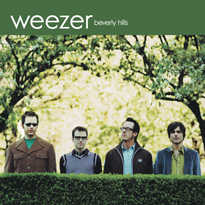Beverly Hills (song)
| "Beverly Hills" | ||||
|---|---|---|---|---|
 |
||||
| Single by Weezer | ||||
| from the album Make Believe | ||||
| Released | March 29, 2005 | |||
| Format | CD | |||
| Recorded | 2004 | |||
| Genre | Power pop | |||
| Length | 3:18 | |||
| Label | Geffen, Interscope | |||
| Writer(s) | Rivers Cuomo | |||
| Producer(s) | Rick Rubin | |||
| Weezer singles chronology | ||||
|
||||
"Beverly Hills" is a song by American rock band Weezer. It is the first single from the band's fifth album, Make Believe. "Beverly Hills" was released to radio on March 29, 2005. The music video for this song, directed by Marcos Siega, was filmed at the Playboy Mansion (which is actually not located in Beverly Hills, but the neighboring community of Holmby Hills), with Hugh Hefner making a cameo appearance at the beginning. The song features Stephanie Eitel of Agent Sparks on the chorus on backup vocals, performing the "Gimme, gimme" hook.
Rivers Cuomo's story behind "Beverly Hills": "I was at the opening of the new Hollywood Bowl and I flipped through the program and I saw a picture of Wilson Phillips. And for some reason I just thought how nice it would be to marry, like, an “established” celebrity and live in Beverly Hills and be part of that world. And it was a totally sincere desire. And then I wrote that song, Beverly Hills. For some reason, by the time it came out—and the video came out—it got twisted around into something that seemed sarcastic. But originally it wasn’t meant to be sarcastic at all."
The song was the band's most commercially successful single until "Pork and Beans" was released, best remembered for its I-IV-V chord progression, use of hand claps, simple lyrics that spoke of alienation and a distinctive talk box solo that Cuomo plays an extended version of during live performances. The song topped the Billboard Modern Rock Tracks chart for a week, spending months near the top of the Billboard Hot 100 (peaking at #10) and being certified gold on June 6, 2005; it was also the band's first song to chart there since "Undone – The Sweater Song" at #57 in 1994 after 11 years since the rest of Weezer's other hits from the past had only managed to chart only on the Hot 100 Airplay or the Bubbling Under Hot 100 chart. As of December 2010, it is still the band's highest-charting Hot 100 single. As of January 2006, the digital single has been purchased over 962,000 times on iTunes. It also did very well on other Billboard charts, such as Adult Top 40 (#8 peak), Mainstream Top 40 (#2 peak), Hot Digital Songs (#1 peak) and Mainstream Rock Tracks (#26 peak).
...
Wikipedia
